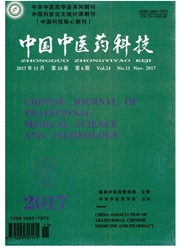

 中文摘要:
中文摘要:
目的:通过体外抑菌试验,探讨不同炮制方法(生黄连与酒制黄连)和不同制剂工艺(传统水煎液与超微粉水浸液)对黄连抑菌作用的影响,为黄连的临床应用提供指导。方法:以金黄色葡萄球菌、大肠杆菌为受试菌株,采用固体培养基连续稀释法,观察不同炮制方法、不同制剂工艺的黄连对实验菌株的抑制作用。结果:生黄连超微粉水浸液对金黄色葡萄球菌的最低抑菌浓度(MIC)值为0.6 g/L、对大肠杆菌的MIC值为2.5 g/L,传统水煎液对金黄色葡萄球菌的MIC值为1.25 g/L、对大肠杆菌的MIC值为5g/L;酒制黄连超微粉水浸液对金黄色葡萄球菌的MIC值为1.25 g/L、对大肠杆菌的MIC值为10 g/L,传统水煎液对金黄色葡萄球菌的MIC值为1.25 g/L,对大肠杆菌的MIC值为10 g/L。结论:1)生黄连的体外抑菌作用强于酒制黄连;2)黄连超微粉水浸液的抑菌作用优于黄连水煎液。
 英文摘要:
英文摘要:
Objective: To explore the antibacterial activity of different processing methods of Coptis chinensis( raw Coptis chinensis and wine Coptis chinensis) and preparation technology( traditional decoction and aqueous extracts of ultra micro- powder) by bacteriostatic test in vitro. Methods: Solid culture medium dilution method were adopted to observe the antibacterial activity of different processing methods of Coptis chinensis and preparation technology on staphylococcus aureus and E. Coli. Results: The minimum inhibitory concentration( MIC) of aqueous extracts of Ultra Micro- powder of raw Coptis chinensis to the staphylococcus aureus was 0. 6 g / L and the E. Coli was 2. 5 g / L; the water decoction to the staphylococcus aureus was 1. 25 g / L and the E. Coli was 5g / L. For the wine- processed Coptis chinensis,the MIC of aqueous extracts of ultra micro- powder to the staphylococcus aureus was 1. 25 g / L and the E. Coli was 10 g / L; the MIC of the water decoction to the Staphylococcus aureus was 1. 25 g / L and the E. Coli was 10 g / L. Conclusion:( 1) Antibacterial activity in vitro of raw Coptidis rhizoma is better than wine- processed Coptidis Rhizoma.( 2) Antibacterial activity of aqueous extracts of ultra micro- powder is superior to the water decoction.
 同期刊论文项目
同期刊论文项目
 同项目期刊论文
同项目期刊论文
 期刊信息
期刊信息
